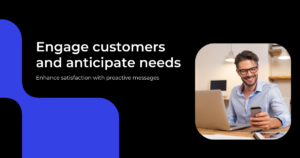Modern consumers not only desire exceptional customer experiences but also anticipate self-service options and an increased digital presence.
According to Salesforce’s 2023 State of the Connected Customer report, 57% of users now prefer self-service options over human interaction, underlining the significance of user-friendly interactions. Furthermore, the Harvard Business Review’s 2022 Achieving Growth with Positive Product Experience report shows that 81% of respondents strongly agree that a strong digital product experience drives business growth.
To meet these evolving customer expectations, businesses can embrace the use of Customer Success Software (CSM), a tool that elevates a company’s digital presence and customer-centric approach. CSM is meticulously crafted to provide businesses with a comprehensive understanding of their customer interactions, requirements, and preferences. It extends beyond conventional customer support, concentrating on the proactive enhancement of customer satisfaction and loyalty.
In this blog, we delve into the realm of CSM software, uncovering its advantages and providing insights to assist you in choosing the most suitable solution for your business.
The Benefits of Customer Success Management Software
Utilizing CSM software provides many advantages for your business. These benefits not only enhance your customer support but also contribute to the overall success and growth of your organization. Below, we’ll delve into each of these benefits:
1. Enhancing Customer Support
Customer support is at the core of any business’s relationship with its clients. CSM software can significantly enhance this aspect by:
- Improving Customer Satisfaction: CSM software allows for personalized, data-driven interactions with customers, resulting in quicker issue resolution and higher overall satisfaction.
- Reducing Churn: By proactively identifying at-risk customers and offering tailored solutions, CSM software can reduce churn rates and help retain valuable clients.
- Increasing Upsell and Cross-Sell Opportunities: Understanding customer needs and behavior patterns empowers your team to identify upselling and cross-selling opportunities, increasing revenue without expanding your customer base.
2. Streamlining Customer Data
A wealth of customer data is available nowadays, and customer success management software helps you manage it effectively by:
- Centralizing Customer Information: CSM software centralizes customer data, making it accessible to your support team, and allowing for a comprehensive view of each customer’s journey.
- Tracking Customer Interactions: It tracks customer interactions and keeps a history of communications, ensuring your team is well-informed about each customer’s prior experiences and inquiries.
3. Automating Customer Outreach
Efficient communication is a cornerstone of successful customer support, and CSM software can automate various aspects of it:
- Personalized Communication: CSM software enables you to send automated but personalized messages to customers, such as welcome emails, product updates, and feedback requests.
- Proactive Issue Resolution: It can identify potential issues and automatically initiate support requests or provide solutions before customers even notice a problem, delivering a seamless and hassle-free experience.
4. Monitoring Customer Health
Maintaining a pulse on your customers’ well-being is crucial for long-term success, and CSM software assists by:
- Identifying At-Risk Customers: Through data analysis and trend spotting, CSM software helps identify customers who may be at risk of leaving, allowing you to take preemptive action.
- Predicting Customer Needs: By analyzing customer behavior and engagement, CSM software can predict their future needs, enabling you to stay ahead in delivering what they require.
These benefits collectively empower your business to create stronger customer relationships, drive revenue growth, and foster a proactive approach to support that keeps your customers satisfied and engaged. The next section will guide you on the key features to look for in CSM software to fully leverage these advantages.
Key Features to Look for in CSM Software
Selecting the right customer success management software for your business is a critical decision. With a multitude of options available, it’s important to identify the specific features that align with your company’s goals and customer support needs. Here are key features that you should consider when evaluating CSM software:
Customer Data Management
Effective customer data management is the foundation of any CSM strategy. Look for software that provides:
- Comprehensive Customer Profiles: The ability to create detailed customer profiles, including contact information, purchase history, and support interactions.
- Data Integration: Seamless integration with your existing customer relationship management (CRM) system and other data sources to ensure up-to-date and accurate information.
Communication and Engagement Tools
Efficient communication is at the heart of customer success management. Your chosen CSM software should offer:
- Multi-Channel Communication: The capability to engage with customers across various channels, including email, chat, social media, and phone.
- Automated Messaging: Tools for sending personalized automated messages, such as onboarding emails, product updates, and follow-up surveys.
- Feedback Collection: Features to collect and analyze customer feedback, enabling you to make data-driven improvements to your products or services.
Analytics and Reporting
Data-driven decision-making is crucial in the world of customer success management. Ensure that your CSM software provides:
- Customer Health Monitoring: Tools to track and assess the health of your customer relationships, helping you identify at-risk customers and areas for improvement.
- Performance Metrics: Key performance indicators (KPIs) and reporting capabilities that allow you to measure the effectiveness of your CSM strategies.
- Predictive Analytics: The ability to forecast customer needs and behavior based on historical data and trends.
Integration Capabilities
Seamless integration with your existing systems is essential for a smooth CSM workflow. Look for software that offers:
- API Access: Open APIs that facilitate integration with other software applications, including your CRM, help desk, and marketing tools.
- Customization Options: The flexibility to tailor the software to your specific business needs and processes.
Scalability and Customization Options
The ability to grow and adapt your CSM software to changing business needs is crucial. Ensure that the software offers:
- Scalability: The capacity to accommodate your business’s growth, whether you have 100 or 10,000 customers.
- Customization: Tools to customize your CSM workflows, ensuring they align with your unique support and customer success goals.
Security and Compliance
Protecting customer data and ensuring regulatory compliance is non-negotiable. Your chosen CSM software should include:
- Data Security: Robust security measures to safeguard customer data and prevent breaches.
- Compliance Features: Tools and features that help you adhere to relevant data protection regulations, such as GDPR or HIPAA, depending on your industry and location.
While assessing CSM software options, it’s essential to align these features with your business’s specific needs and long-term goals. You may not necessarily need to check all the boxes for these features in your CSM software. However, it’s crucial to contemplate what is genuinely essential for your business and confirm that your CSM platform can provide those essentials. With that in mind, the next section will delve into evaluating your business’s distinctive requirements when selecting the ideal CSM software.
Assessing Your Business Needs
To ensure you choose a solution that aligns perfectly with your business, it’s crucial to do a thorough evaluation of your specific requirements and business goals.
First, understand your customer support workflow.
Begin by scrutinizing your customer support processes. Ask yourself questions like:
- What are the key stages of our customer support workflow?
- Where do we encounter the most challenges or bottlenecks in assisting customers?
- What kind of data and insights would significantly improve our support operations?
This initial assessment will help you identify the areas where CSM software can add the most value to your business.
Second, identify pain points and goals.
Some typical business pain points might include high customer churn rates, inefficient communication, or challenges in tracking customer interactions. Your goals may revolve around:
- Reducing customer churn by a certain percentage.
- Improving response and resolution times for customer inquiries.
- Enhancing the personalization of customer interactions.
By understanding your pain points and goals, you’ll have a clear picture of what you want your CSM software to address.
Finally, consider your budget.
Determine a budget for your CSM software implementation. The cost can vary significantly depending on the features and scalability you require. Consider not only the initial purchase but also ongoing maintenance, training, and any potential scalability costs as your business grows.
Keep in mind that while CSM software can be a valuable investment, it should provide a strong return on investment by improving customer support, reducing churn, and increasing revenue through upselling and cross-selling.
How to Choose the Right CSM Software
To make the process of selecting the right CSM software easier, follow these steps:
- Market Research and Vendor Evaluation: Start by researching and creating a list of CSM software providers. Read reviews and seek recommendations from peers in your industry.
- Creating a Shortlist: Narrow down your options to a shortlist of CSM software solutions that align with your needs and budget.
- Requesting Demos: Contact the shortlisted vendors to request product demonstrations. This will help you get a hands-on feel for the software’s features and usability.
- Considering Implementation and Training: Inquire about the onboarding process and training options provided by the vendors. Ensure they can meet your specific requirements.
- Cost Analysis and ROI Projections: Evaluate the total cost of ownership, including both initial and ongoing expenses. Calculate the potential return on investment (ROI) based on your goals.
- Making the Final Decision: After thorough evaluation, make an informed decision based on the software’s ability to meet your unique business needs and budget constraints.
Take a closer look at various CSM software options by exploring this comprehensive guide comparing customer success software solutions. Or read our latest article on Freshdesk vs Zendesk.
Customer Success Management Software Solutions
It’s important to choose your customer success management software wisely. Ensure it aligns with your unique business needs, goals, and budget constraints. Careful research, demos, and an ROI analysis are key to making the best choice. The right CSM software can revolutionize your customer support operations, contributing to long-term success and customer-centric excellence.



